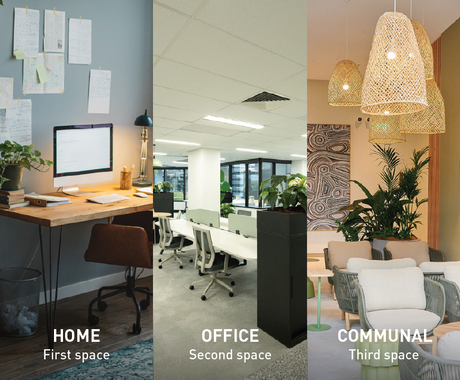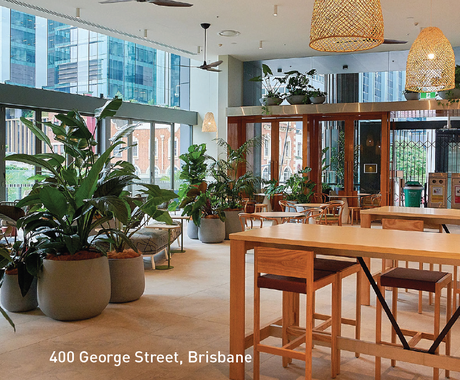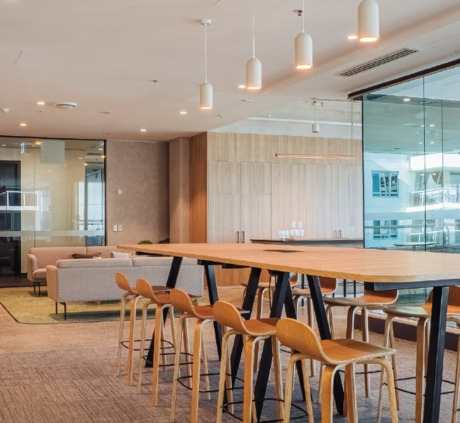An office space evolution
We know the office space landscape is changing. It’s up to Cromwell, as a real estate investor and fund manager, to a listen to the modern requirements of tenants and invest in upgrading our assets to meet these needs while also adding value for investors.
Recently we examined how the office is increasingly becoming a place for collaboration and social connection, rather than focus work, meaning a greater need for meeting, gathering, and collaboration spaces. There is also a need to lower density and make workplaces more comfortable from an employee wellbeing and retention perspective.
Earlier this year, we examined how white-collar employees divide their working week between home and office, and how the role of the office space has changed forever, largely due to work from home requirements during the COVID-19 pandemic.
The conclusion reached was that, as demand continues to concentrate on the minority of space suitable for modern occupation, the supply-demand mismatch will widen. It was proposed that investors who own or can acquire or create the space occupiers want, where they want it, are well positioned for future rental growth – and, importantly, are more likely to retain and attract tenants.
So, what do tenants want?
Spaces occupiers want
Understandably, tenant requirements can be as diverse as the building occupiers themselves. However, there are a number of reoccurring modern office space requirements that require attention.
A May 2023 research paper by global real estate services firm JLL revealed that incentives being offered by landlords to either encourage tenants to stay, or entice them to new premises, remain at historically high levels across many markets1.
According to the research, upgrades to the base building, including end-of-trip facilities, improved ground entry and reception areas, improved lifts and amenities, event spaces, health and wellbeing facilities, business lounges, and cafes are high on the agenda for landlords seeking to keep their occupancy levels stable.
Sustainability is also increasingly a consideration for tenants, including requirements to source all power from renewable sources, or undertake capital upgrade works to the building infrastructure.
In addition, research from Swinburne University of Technology and Third-Place.org in January announced that “working from cafes and pubs will be a 2023-defining trend”2. These kinds of work environments have been termed ‘third spaces’ – or ‘third places’.

That is, if ‘home’ is categorised as a ‘first space’, and the traditional office workplace is categorised as a ‘second space’, ‘third spaces’ can be best described as communal, multi-purpose areas that people can utilise as they desire – including for work. The desire for third spaces has increased significantly since the end of the COVID-19 pandemic, as office building owners and employers look for ways to encourage more workers to return to the office.
The Swinburne-Third-Place research found that almost half of remote workers now spend time each week working from cafes or other third places. The trend continues to be particularly popular with Gen Z workers (loosely defined as people born between 1995 and 2010), ten percent of whom say third places are now their preferred place to work.
The researchers found that, on average, people who work in third places will typically do so between two and three times each week. These workers will stay anywhere between 15 minutes and four hours – most of the time, they’ll go to a third place on their own.
The top three benefits to working in a third place were reported to be mental reset, community and social connection, and great food and coffee. When asked to what extent working from a third place positively contributes to their overall wellbeing, the average response was 86%. By extension, 98% of respondents said they’d continue to use a third place for work in the future.
Meeting market desires
Cromwell has a strong track record of adapting office spaces to meet tenants’ requirements. Our exceptional in-house property development, project management, and technical capabilities allow us to identify and deliver value for our tenants, our investors, and capital partners through innovative development and construction projects, whole- of-building refurbishments, and adaptive re-use and asset transformations, all of which incorporate market leading sustainability initiatives.

In response to our tenants’ changing needs – highlighted in the 2022 Tenant Engagement Survey – Cromwell rolled out the successful design and delivery of a new purpose- built wellbeing and third space at our 400 George Street building in Brisbane.
Brisbane-based architectural firm nettletontribe was engaged to design a space that would meet the needs of our current and future tenants; and experienced national Indigenous accredited fitout and refurbishment company Rork Projects was tasked with delivering the vision.
The result is a superbly integrated indoor-outdoor shared meeting area; a training room and larger boardroom; a multi-faith/wellness room; and a 200 sqm breakout or function space.
High ceilings and earthy floor tiles are complemented by polished timber entranceways and olive-green feature walls. Concertina (bifold) doors allow much of the area to be opened to the bustling city below.
The space is already being utilised by tenants as a break- out area; a space for meetings, yoga classes, and wellbeing classes. In this instance, Cromwell was able to repurpose a vacant and difficult floor space to provide an outcome that benefitted tenants, enhanced the building amenity, and increased marketability of the asset. Cromwell will apply the lessons learned through this process to upgrade works at our other assets.
Our experienced property managers continue to liaise with tenants regarding every workplace requirement, including lease disposal, lease negotiation, space planning, workplace design, change management, cost of construction, technology solutions or transitioning to net zero.
The office market latest
Vacancy rates in Australia’s capital cities have increased modestly over the last six months, driven by an uptick in new office supply, according to fresh data from the Property Council of Australia (PCA).
The July 2023 edition of the ‘Office Market Report’, which is released twice a year, showed overall CBD vacancy increased from 12.6 to 12.8% nationally3. Non-CBD areas saw an increase from 15.2 to 17.3%.
PCA projects that the supply of office space in CBD markets is expected to remain close to the historical average throughout 2023, with an anticipated increase above the average in the second half of 2024.
Encouragingly, the office market in Brisbane – where Cromwell owns a number of assets – is particularly robust, with tenant demand outpacing available supply, decreasing the vacancy rate from 12.9% to 11.6%.
“Notably, the results show Premium and A Grade stock remains in high demand, reinforcing businesses’ desire to provide attractive and enjoyable workplaces for their people,” Property Council Chief Executive Mike Zorbas said as part of the July Office Market Report launch.
“These organisations recognise that maintaining a physical office presence in our cities is vital for conducting business effectively. We know that face-to-face teamwork supports deeper team relationships and brings about positive outcomes for organisations, the economy, and society
at large.”
Continuing to improve our spaces
Attracting Government and blue-chip tenants on long-term leases continues to be a key focus for Cromwell. As with our George Street property, works have been undertaken at several other assets to retain existing building occupiers – and attract new tenants.
Cromwell has actively completed a number of property upgrades of this kind already in 2023, including the recent completion of several speculative fitouts.
Speculative fitouts are new office fitouts built by the landlord or building owner, designed to accommodate a broad range of new tenants. If building owners can show potential tenants a functional, modern space that requires no further work, it makes the property a much more attractive prospect.
Recent completed works include:
207 Kent Street, Sydney
Cromwell’s Projects Team has successfully concluded construction activities on levels 18, 19, and 20. These enhancements are in preparation for the upcoming occupancy of new tenants in the forthcoming months.
The tenancy areas have undergone upgrades, featuring environmentally conscious carbon-neutral flooring and energy-efficient LED troffer lighting. Additionally, significant improvements have been made to lift lobbies and amenities across various floors. Both cold shell and warm shell office spaces have been prepared for future fitouts.
These recent endeavours build upon the substantial base build refurbishment that was previously undertaken in 2022. This refurbishment included a lobby refresh inspired by a First Nations Indigenous design, with the addition of end-of-trip facilities. These facilities encompass a spacious bike storage area, expanded shower amenities, and the installation of numerous new storage lockers.
95 Grenfell Street, Adelaide
Cromwell Direct Property Fund’s Chesser House property, located in the heart of Adelaide, has recently seen the completion of speculative fitouts in two tenancies.
The suites boast neutral colour palettes, highlighted by gentle blues and calming green tones, contributing to a serene ambience. The layout of the 360sqm and 200sqm spaces has been strategically planned to maximise functionality. This includes dedicated areas for meeting rooms, quiet spaces, and collaborative zones.
475 Victoria Avenue, Chatswood

Cromwell’s Projects Team has successfully managed the realisation of six speculative fitout tenancies spread across three levels. The sizes of these tenancy floors span from 100sqm to 520sqm, with each suite thoughtfully adorned with a distinct colour palette, instilling a sense of individuality to every area.
Space planning was thoroughly conducted in collaboration with both internal and external leasing teams. This strategic approach responds to the growing demand for collaborative spaces while underlining the importance of design flexibility to facilitate enhanced reusability.
Furthermore, sustainability remains a paramount focus. A notable achievement in this regard is the recycling of 52% of construction waste, which includes repurposing existing furniture items.
100 Creek Street, Brisbane
Three speculative fitouts, completed in December 2022, were well received by the market; prompting the building of a further four speculative fitouts, across two floors, this year.
The design of these suites focused on breakout areas and collaboration zones to address market requirements in addition to providing quiet rooms to those wishing to concentrate on tasks or avoid distraction.
To enhance the value of the space, carbon-neutral flooring inspired by First Nations Indigenous culture was carefully selected and incorporated.
Continuing to improve our strategy
In response to market dynamics, Cromwell is reshaping our speculative fitout approach. Our primary goal is optimising financial efficiency, particularly during periods when tenants are yet to be secured.
As part of this process, we’re introducing a fresh concept: pre-lease design concepts – that is, potential tenants can influence final touches after pre-commitment. By addressing tenant preferences, we enhance experiences and minimise post-move changes. This strategy balances financial prudence, tenant engagement, and functional design, exceeding expectations consistently.
Our designs offer lasting allure, catering to diverse needs. Easily upgradable components reduce major modifications. Further, ESG considerations remain paramount to our business decisions – we integrate eco-friendly practices and repurpose elements to cut waste.
In essence, our approach emphasises sustainability, functionality, and tenant satisfaction. Adaptable designs create appealing, eco-conscious spaces.
In conclusion
As the office market continues to evolve, Cromwell is committed to ensuring that our assets adequately meet current and future tenant requirements – we will adapt office spaces to meet tenants’ needs, improving our vacancy rates in a highly competitive market.
By developing our approach to improve the occupancy of our assets, we will deliver favourable outcomes for investors now and in the future.
1 Choosing the best fit for your organisation, May 2023 (JLL Research)
2 Third Places – A health alternative to working from home?, January 2023 (Swinburne University of Technology and Third-Place.org)
3 Office Market Report, July 2023, (Property Council of Australia)
5 topics

